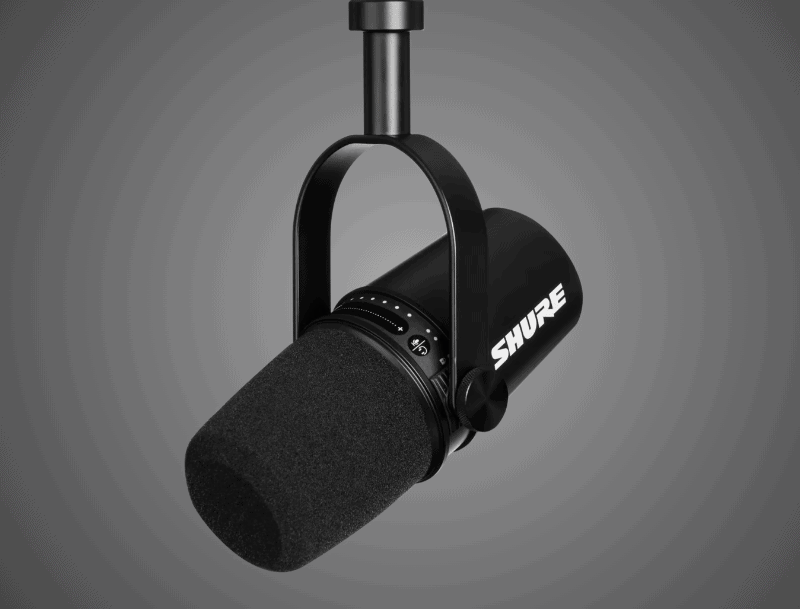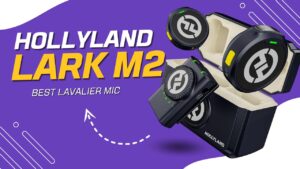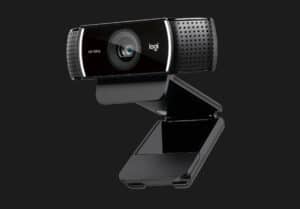The Shure MV7 stands out as a versatile and high-quality microphone that caters to a wide group of content creators. With its versatile connectivity and user-friendly companion app, it offers unparalleled control and flexibility. In this Shure MV7 review, we explore its features, compare it to other mics, and help you decide if it’s the right choice for your audio needs.
Castos is a participant in the Amazon Services LLC Associates Program. We may earn commissions from your purchases on Amazon.com, though at no cost to you.
Our Verdict

The Shure MV7 expertly blends modern functionality with professional sound quality. The versatile USB and XLR connectivity caters to a wide range of recording needs. Its intuitive design, coupled with the ShurePlus MOTIV app, makes it an ideal choice for podcasters, streamers, and vocalists seeking versatility and strong audio performance.
Pros
- Dual USB and XLR connectivity.
- Voice isolation technology ensures clear audio capture.
- Robust, all-metal construction.
- ShurePlus MOTIV app provides extensive control over microphone settings.
- Easy plug-and-play setup; no additional equipment required.
Cons
- USB audio quality might not match the level of professional XLR microphones.
- Lacks multiple pickup patterns.
- May require additional accessories for optimal setup.
- Price point might be higher compared to entry-level microphones with similar features.
Tip
Need more equipment for your podcast or YouTube channel? Check out our comprehensive list of gear recommendations.
Overview of the Shure MV7
The Shure MV7 is a versatile mic with strong and simple features. This makes it a great option for new podcasters and creators. Let’s talk through the main components of the MV7.
Design and Build
The Shure MV7 is a testament to Shure’s commitment to quality and durability, boasting a robust all-metal construction. Its design is inspired by the iconic Shure SM7B, featuring a sleek, modern aesthetic that fits seamlessly into any recording environment. The MV7 is compact and versatile, with a fully adjustable yoke for easy positioning on mic stands or boom arms.
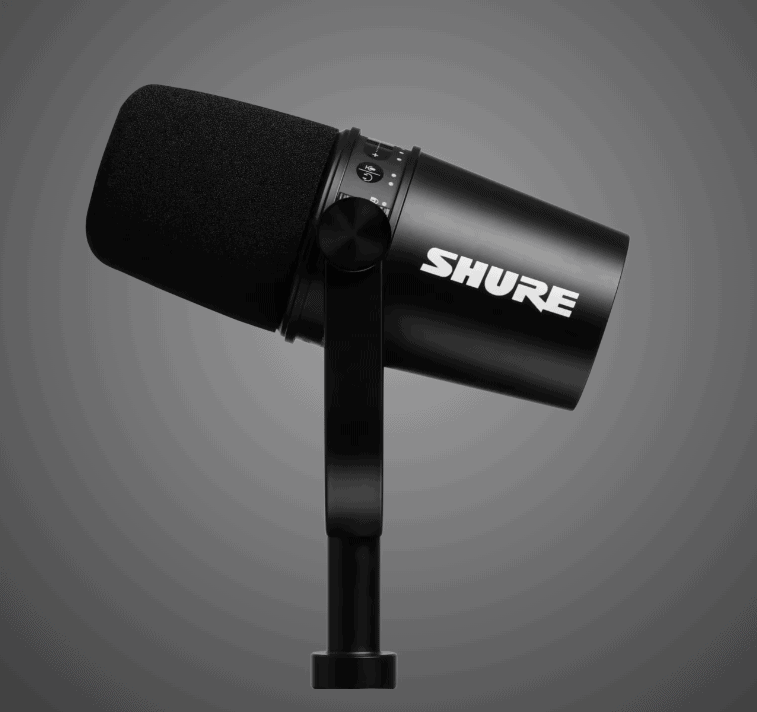
Sound Performance
Sound quality is where the MV7 truly shines. It delivers rich, clear, and detailed audio, capturing the nuances of the voice with precision. The dynamic microphone design offers excellent rejection of off-axis noise. This makes it ideal for environments that are not acoustically treated.
The MV7’s voice isolation technology ensures that the focus is on the speaker or performer, minimizing background noise and room reflections. This makes it an excellent choice for new podcasters, creators, and streamers who want professional-grade audio quality.
Pickup Pattern
The MV7 features a unidirectional cardioid pickup pattern, which is designed to capture sound from the front of the microphone while rejecting noise from the sides and rear. This pattern is ideal for focused audio capture, making it suitable for single-person podcasts, voiceovers, and vocal recordings.
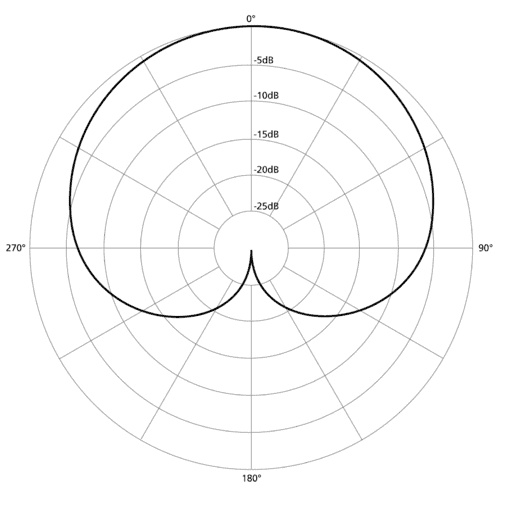
Connectivity
One of the standout features of the MV7 is its dual connectivity options. It offers both USB and XLR outputs. The USB connection allows for direct plug-and-play with computers and mobile devices, making it incredibly user-friendly for those who prefer a straightforward setup without the need for additional audio interfaces. The XLR connection, on the other hand, lets you integrate with professional studio setups.
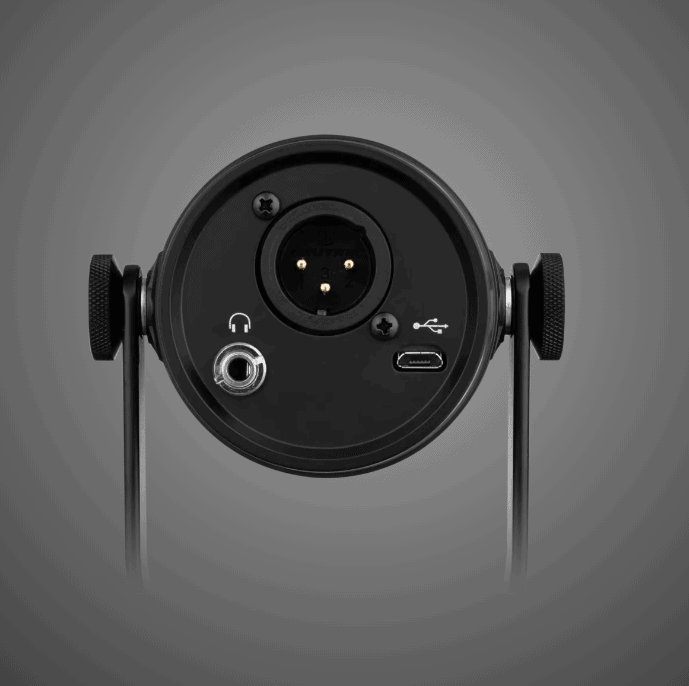
Setup and Use
Setting up the MV7 is straightforward, thanks to its plug-and-play design when using USB. For USB mode, simply connect the microphone to a computer or mobile device, select the MV7 as the audio input source, and start recording.
The ShurePlus MOTIV app enhances the USB experience by offering additional control over the microphone’s settings. For those opting to use the XLR connection, the MV7 functions like a traditional dynamic microphone, requiring an audio interface or mixer to connect to recording equipment.

Shure MV7 vs. Shure SM7B
While the MV7 draws inspiration from the legendary SM7B, there are distinct differences between the two.
The SM7B is a studio mainstay known for its superior sound isolation and performance in professional environments, often necessitating an external preamp for optimal performance.
In contrast, the MV7 is designed with flexibility in mind, catering to both professionals and beginners with its dual USB and XLR connectivity. The MV7’s USB functionality, combined with the ShurePlus MOTIV app, offers a level of convenience and control that is particularly appealing for content creators who require a more plug-and-play solution.
While the SM7B may have an edge in pure audio performance, especially in studio settings, the MV7 offers a compelling blend of quality, convenience, and versatility, making it a worthy consideration for a broad range of users.
Specifications
Here are the key specifications of the Shure MV7 microphone:
- Type: Dynamic
- Polar Pattern: Unidirectional (Cardioid)
- Frequency Response: 50 Hz to 16,000 Hz
- Connectivity: USB and XLR outputs
- USB Sample Rate: 48 kHz / 24-bit
- Adjustable Gain: Yes, via the ShurePlus MOTIV app for USB mode
- DSP Modes: Adjustable EQ, limiter, and compression settings (via ShurePlus app)
- Mounting: Integrated yoke for easy attachment to a variety of mic stands or boom arms
- Construction: All-metal design
- Headphone Output: Built-in headphone jack for real-time monitoring
- Headphone Frequency Response: 20 Hz to 22,000 Hz
- Headphone Output Power: Up to 7 mW
- MFi Certified: Yes, for direct connection to iOS devices
- Compatibility: Compatible with Windows and macOS for USB; standard XLR connection for universal compatibility with audio interfaces and mixers
- Dimensions: 153.6 mm x 90.2 mm x 164 mm (L x W x H)
- Weight: 0.55 kg (1.21 lbs)
- Included Accessories: Micro-B to USB-C cable, Micro-B to USB-A cable
What’s in the Box of the Shure MV7?
When you purchase the Shure MV7 microphone, the box typically includes the following items:

- Shure MV7 Microphone: The dynamic microphone itself.
- Micro-B to USB-C Cable to connect the MV7 to devices with a USB-C port.
- Micro-B to USB-A Cable to connect the microphone to devices with a USB-A port.
- User Guide: Important information on how to set up and use the microphone.
These inclusions ensure that you can start using the MV7 right out of the box, whether you’re connecting via USB-C or USB-A. However, if you plan to use the MV7’s XLR output, you’ll need to supply your own XLR cable.
ShurePlus Motiv App
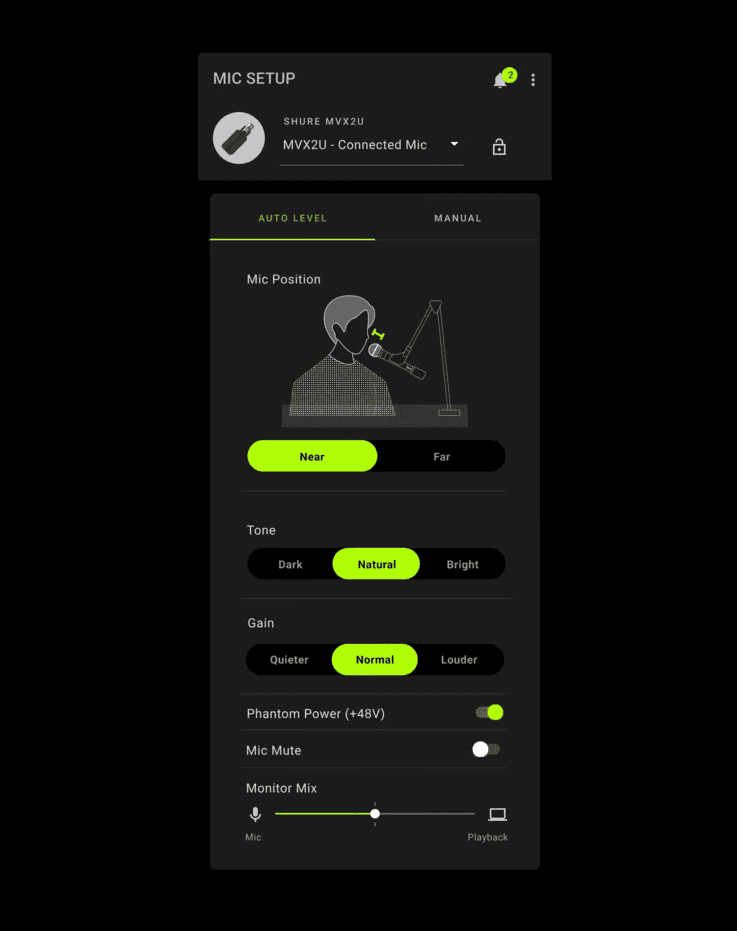
The ShurePlus MOTIV app is a companion app designed to enhance the functionality of Shure’s MOTIV range of microphones, including the Shure MV7. It’s an integral part of the user experience for Shure microphones, especially when connected via USB. Here are the key features that allow you to control and customize your audio:
- Real-time control over microphone settings, including gain, monitor mix, EQ, and more.
- Preset modes tailored to different recording situations that adjust the microphone’s settings automatically to suit the selected scenario.
- Customize settings to your preference to get the best audio output.
- High quality audio recording directly onto the device. This is particularly useful for podcasters and video creators who record in different locations.
- Manage your recordings within the app. Listen, edit, and share files.
- Get easy firmware updates for the microphone.
Who is the Shure MV7 For?
The Shure MV7 microphone is a versatile tool for podcasters and video creators who need professional-quality audio without the complexity of studio gear. This dynamic microphone is inspired by the legendary Shure SM7B, making it a flexible choice for various recording environments and setups.
Podcasters find the MV7 particularly appealing because of its voice isolation technology and the ability to deliver rich, clear audio. Whether recording in a studio or a less controlled environment, the MV7’s ability to capture sound directly in front of the microphone while minimizing background noise is a significant advantage.
Video creators, on the other hand, appreciate the MV7 for its ease of use and the quality it brings to voiceovers or any on-camera work. The microphone’s compatibility with numerous devices and its plug-and-play feature through USB make it a go-to for creators.
Moreover, the Shure MV7 is a smart choice for content creators who are looking to upgrade from entry-level microphones but are not yet ready to dive into the complexities of professional studio equipment. Its user-friendly design, coupled with advanced features like the ShurePlus MOTIV app, allows users to fine-tune their audio in real time.
Shure MV7 Alternatives
While the Shure MV7 is a popular choice for podcasters and streamers, there are several other microphones on the market that offer different features and aesthetics. Here’s how some common alternatives compare to the MV7:
Shure 55SH Series II
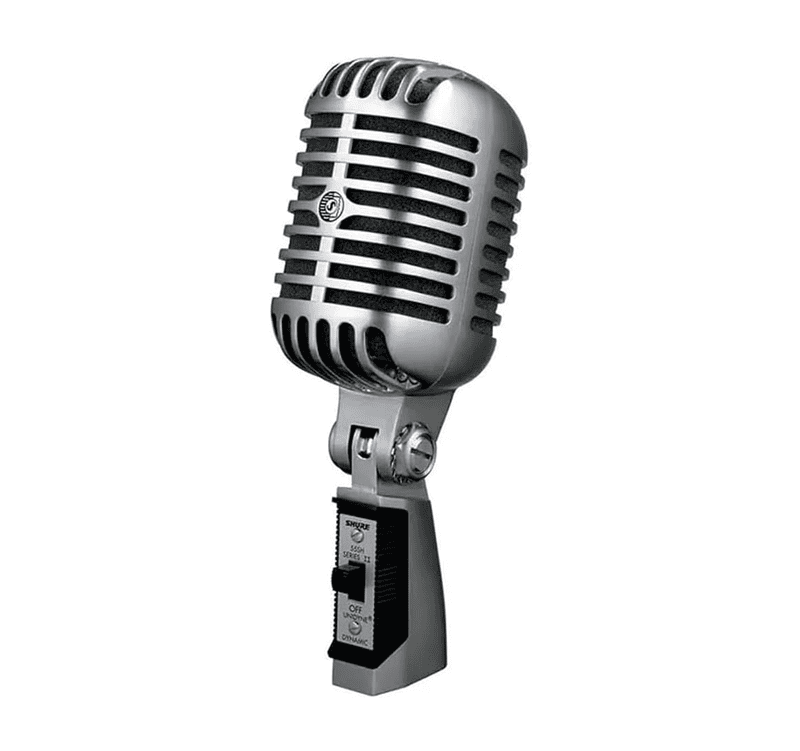
The Shure 55SH Series II, often referred to as the “Elvis Mic,” is renowned for its classic appearance and robust build quality.
Unlike the MV7’s modern and sleek design, the 55SH Series II offers a vintage look that appeals to people seeking a retro aesthetic. It’s a dynamic microphone with a cardioid pickup pattern, similar to the MV7, which makes it effective at rejecting off-axis sound.
However, unlike the MV7, the 55SH Series II lacks USB connectivity, relying solely on an XLR output. This makes it less versatile for users seeking the convenience of USB plug-and-play functionality.
Shure Super 55 Deluxe
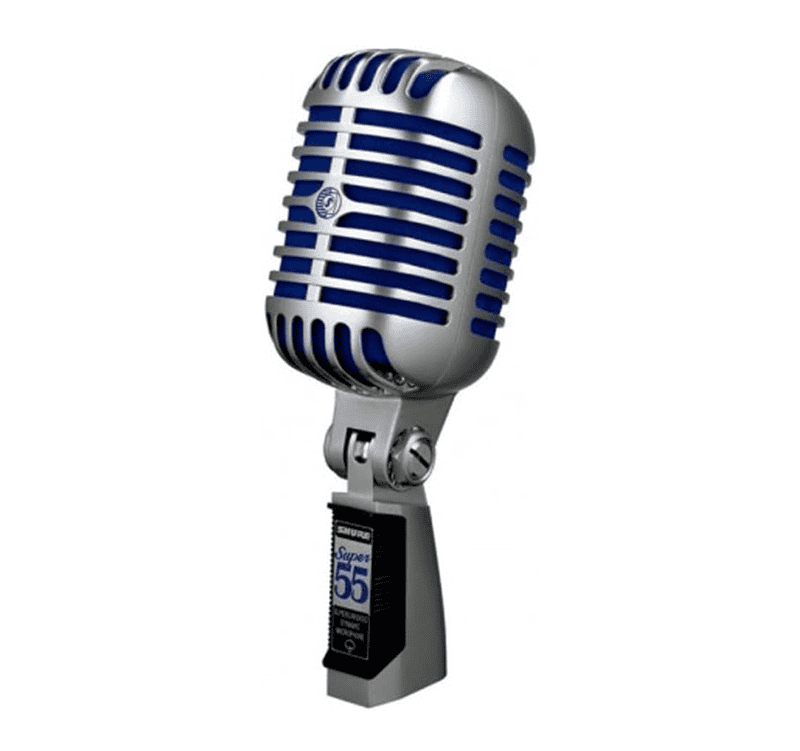
The Shure Super 55 Deluxe builds on the design of the 55SH Series II, offering enhanced audio performance with its supercardioid pickup pattern, which offers tighter sound isolation compared to the MV7’s cardioid pattern.
Like the 55SH, the Super 55 Deluxe features a vintage design but with added blue foam for a distinctive look. It’s an excellent choice for live vocal performances, thanks to its robust design and superior feedback rejection. However, like the 55SH Series II, it lacks USB connectivity.
Logitech Blue Sona
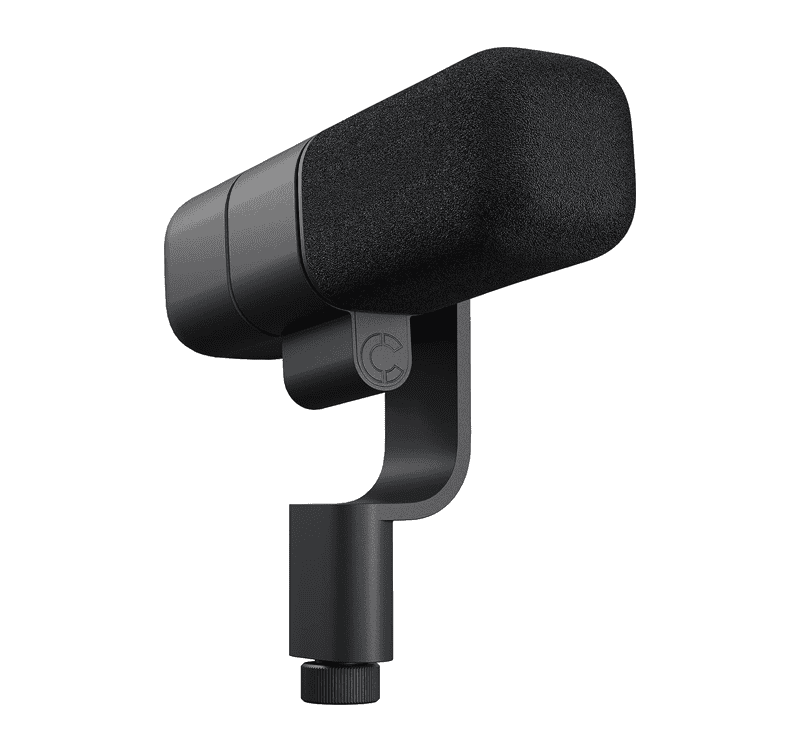
The Logitech Blue Sona is a dynamic XLR microphone. It boasts ClearAmp technology, providing a strong and clear signal without the need for an external preamp, which is a significant advantage for users without sophisticated audio setups.
While it doesn’t offer USB connectivity, it’s designed to be simple to use. It is a strong contender for those who prefer an XLR setup but still want simplicity and quality.
Movo UM700
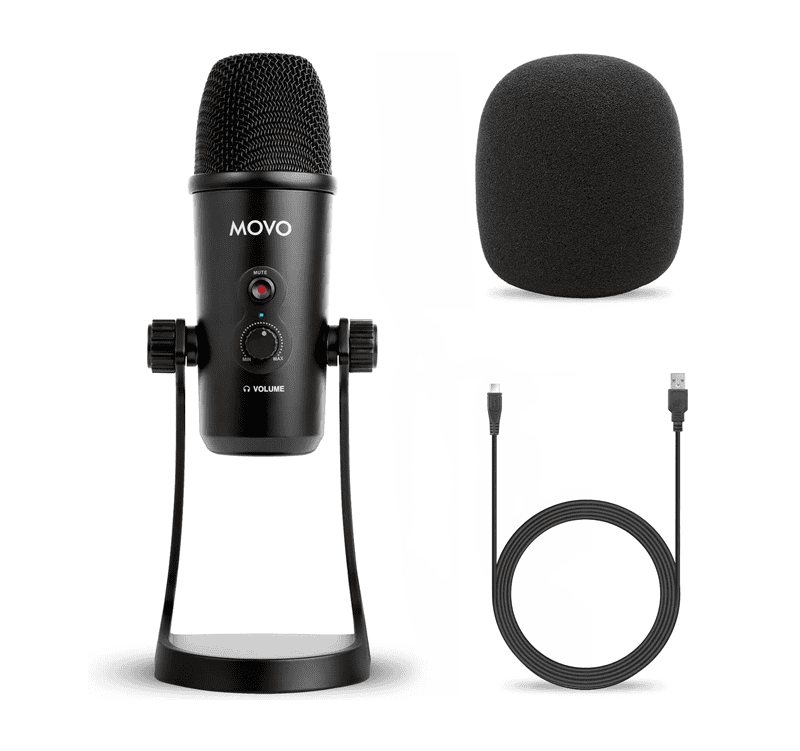
The Movo UM700 is a more budget-friendly alternative to the MV7, offering versatility with its USB connection. It’s a condenser microphone, which generally captures more detailed sound than dynamic microphones like the MV7.
The UM700 features multiple polar patterns, including cardioid, bidirectional, omnidirectional, and stereo, providing flexibility for various recording scenarios. However, being a condenser mic, it might pick up more background noise than the MV7.
While it offers great value and versatility, it may not match the MV7’s build quality and brand reputation.
Shure MV7 Review FAQs
Here are some common questions people ask about the MV7.
What is it Like to Use the Shure MV7?
Using the Shure MV7 is user-friendly and intuitive. It offers clear audio quality with minimal setup. Its USB and XLR connections provide flexibility for various recording environments. The ShurePlus MOTIV app enhances user control over audio settings.
How Does the ShurePlus MOTIV App Work?
The ShurePlus MOTIV app allows users to adjust the MV7’s settings, like gain, EQ, and monitor mix, directly from a smartphone or computer. It provides real-time feedback and customization.
What Pickup Pattern Does the Shure MV7 Have?
The Shure MV7 features a cardioid pickup pattern, focusing on sound directly in front of the microphone while reducing unwanted background noise, making it ideal for podcasting, streaming, and vocal recordings.
Can You Use the Shure MV7 with Zoom?
Yes, you can use the Shure MV7 with Zoom by connecting it via USB to your computer, selecting it as the audio input in Zoom’s settings.
Can the Shure MV7 be used with both a computer and a mixer?
Absolutely. The Shure MV7 can be connected to a computer using USB for digital recording and to a mixer or audio interface via XLR for live sound or more traditional recording setups.
Does the Shure MV7 require a separate audio interface or preamp?
When using the XLR connection, the MV7 functions like a standard dynamic microphone and doesn’t necessarily require a separate preamp, although using one can enhance the audio quality, especially in professional settings.
Is the Shure MV7 suitable for musical instruments or only vocals?
The MV7 is primarily designed for vocal use, but its high-quality audio capture makes it suitable for recording acoustic instruments as well. However, its cardioid pattern and tuning are optimized for voice, which may affect its versatility with instruments.
Should You Buy the Shure MV7?
Whether you should buy the Shure MV7 depends on your specific needs and preferences. If you’re a podcaster, streamer, or vocalist seeking a microphone that offers both USB and XLR connectivity, excellent sound quality, and user-friendly features, the MV7 is a compelling choice.
However, if you primarily need a microphone for recording musical instruments or require a mic with multiple pickup patterns, you might want to explore other options. Additionally, if budget is a concern, there are less expensive microphones available that still offer good quality for beginners or those with simpler needs.
If you enjoyed this review, please check out some of our other microphone reviews:
